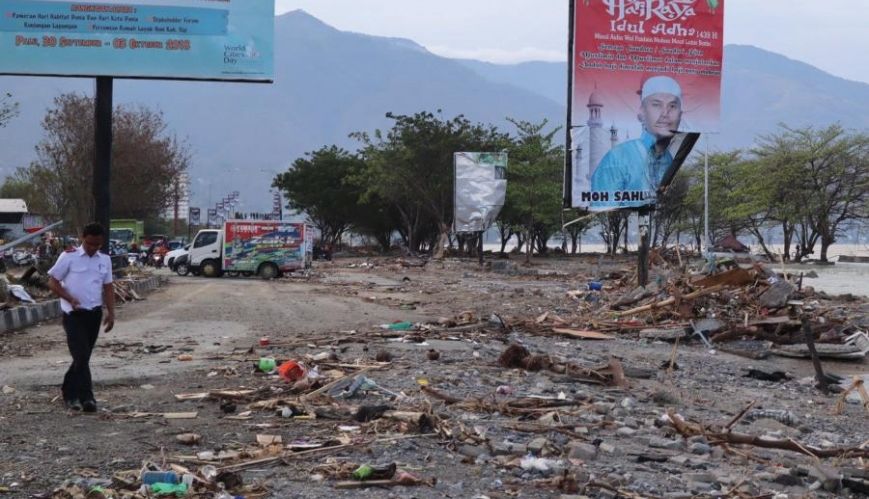Report released into Indonesian earthquake response

Report released into Indonesian earthquake response
17 March 2022
The Salvation Army has released a report on its response to the 2018 earthquake and tsunami in the Sulawesi region of Indonesia.
Some of The Salvation Army’s relief and recovery programs and innovations implemented in Indonesia following the earthquake and tsunami that devastated Sulawesi on 28 September 2018 are still running, three years later.

The Army has released a report into its relief and recovery response to the event, which revealed some early delays to some programs still running.
Major Drew Ruthven, General Manager – Strategic Emergency and Disaster Management (SEDM), who gave input into the report, headed up the initial International Headquarters task force to enter the disaster zone, being “the first international officer on-site”.
Drew said much of the area was still recovering and rebuilding.
A veteran of heading SEDM teams at major international disaster epicentres in Indonesia in 2004, Haiti in 2010, and Japan in 2012 (and others), Drew said the Army’s responses in the Indonesia Territory had been different to previous natural disasters as it was not only the general public that was significantly affected but many Army officers, soldiers, employees, and property.
He said the terrain and the enormity of destruction made the implementation of many recovery and restoration projects more difficult. Some of the projects still happening were the medium-to-long-term initiatives in the aftermath of the event.
When major disasters happen anywhere in the world, the International Emergency Services (IES) relies on Salvation Army territories to provide practical support and supplies, as well as trained and experienced personnel.
Drew said that when IES teams arrived, they “take some of the chaos out of [the situation] for the Army, look at what is required then work out where funds will be spent”.
He said one Indonesian division had become inaccessible as a “mountain had collapsed”, but he was able to coordinate a makeshift track to the stranded people and used motorcycles to ferry food and supplies until roads were re-established.
Another initial response was to buy a well-equipped ambulance (using funds donated by the Netherlands), which was used to cover a wide area and treat and ferry casualties.
Another Australian officer, Major Brad Watson, is one of the international officers on standby to be deployed to a disaster and was among a later contingent of overseas officers sent to work alongside Indonesian counterparts.
A member of the IES team since 2005, Brad arrived in October 2018, a month after initial natural events, to lead a team and remained until December 2018.
As part of his role, he coordinated projects in Sulawesi, working alongside other agencies and the government, and liaised with donor countries and Army territories.
Brad, who has had previous similar roles in countries such as India, Haiti, Mali, Vanuatu, and the Bahamas, has led teams responding to tsunamis, earthquakes, civil wars, cyclones, droughts, and hurricanes.
He said the role allowed him to see the “immediate impact” of the work the Army did, “knowing that you are returning dignity to people and showing Jesus’ love in a practical and meaningful way”.
Army ‘severely affected’
Colonel Kelvin Merrett, Australia Territory Assistant Chief Secretary, said the territory had a team of about 10 officers on standby to be deployed to crisis and natural disaster epicentres anywhere in the world.
Kelvin said International Headquarters took the lead on calling in any necessary officer emergency services involvement after it had assessed the situation and the need.
Much of the damage from the 2018 Indonesian earthquake, which measured 7.5 on the Richter scale, was on the Minahasa Peninsula, with the epicentre in the mountainous area of Donggala, in Central Sulawesi. Several aftershocks were registered, and tsunami warnings were issued for areas near the Makassar Strait that hit Palu, Donggala, and Mamuju.
The combined effects of the earthquake, tsunami, liquefaction, and landslides caused significant damage and loss of life throughout the affected areas in the districts of Palu, Donggala, Sigi, and Parimo.
It was reported to have been the deadliest earthquake to hit Indonesia since the 2006 Yogyakarta earthquake and the world’s deadliest earthquake in 2018.
The Army report said four of its divisions (East Palu, West Palu, Manggala, and Kulawi) were affected with more than 200 corps, outposts, and institutions, including Woodward Hospital and various schools, “severely affected”.
The 20 relief and recovery projects introduced, which included providing humanitarian assistance, education, water, sanitation, and health (WASH) assistance, shelter, food, and personnel, have cost about $A2.3million.
One of the projects included renovations and repairs for all Army buildings destroyed or damaged.
The report indicated that the Army in Indonesia was able to “mobilise dedicated personnel resources to provide fast, life-saving assistance . . . in a timely and well-coordinated manner”.
“The presence of officers and soldiers in the field from the start makes the community feel safe and calm and gives hope and enthusiasm; as well as subsequent visits by those in various leadership and support roles,” the report said. “The different elements of The Salvation Army’s overall response came together well to complement each other at the community level.”
Having officers, soldiers, and employees directly affected by the disaster put additional pressure on those who responded “both in upholding the principle of serving the most vulnerable without discrimination and in identifying and responding to the additional physical and psychological needs of fellow respondents”, the report said.